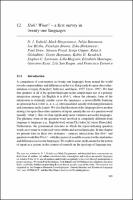Chapter 12 Huh? What? – A first survey in 21 languages
| dc.contributor.author | Baranova, Julija | |
| dc.contributor.author | Enfield, N.J. | |
| dc.contributor.author | S. Gísladóttir, Rósa | |
| dc.contributor.author | Drew, Paul | |
| dc.contributor.author | Hoymann, Gertie | |
| dc.contributor.author | Brown, Penelope | |
| dc.contributor.author | Blythe, Joe | |
| dc.contributor.author | Gipper, Sonja | |
| dc.contributor.author | Magyari, Lilla | |
| dc.contributor.author | Manrique, Elizabeth | |
| dc.contributor.author | Rossi, Giovanni | |
| dc.contributor.author | Floyd, Simeon | |
| dc.contributor.author | Dingemanse, Mark | |
| dc.contributor.author | Torreira, Francisco | |
| dc.contributor.author | H. Kendrick, Kobin | |
| dc.contributor.author | Dirksmeyer, Tyko | |
| dc.contributor.author | C. Levinson, Stephen | |
| dc.contributor.author | San Roque, Lila | |
| dc.contributor.author | Enfield, N.J. | |
| dc.contributor.author | Dingemanse, Mark | |
| dc.contributor.author | Baranova, Julija | |
| dc.contributor.author | S. Gísladóttir, Rósa | |
| dc.contributor.author | Drew, Paul | |
| dc.contributor.author | Hoymann, Gertie | |
| dc.contributor.author | Brown, Penelope | |
| dc.contributor.author | Blythe, Joe | |
| dc.contributor.author | Gipper, Sonja | |
| dc.contributor.author | Magyari, Lilla | |
| dc.contributor.author | Manrique, Elizabeth | |
| dc.contributor.author | Rossi, Giovanni | |
| dc.contributor.author | Floyd, Simeon | |
| dc.contributor.author | Torreira, Francisco | |
| dc.contributor.author | H. Kendrick, Kobin | |
| dc.contributor.author | Dirksmeyer, Tyko | |
| dc.contributor.author | C. Levinson, Stephen | |
| dc.contributor.author | San Roque, Lila | |
| dc.date.accessioned | 2018-08-08 12:55:24 | |
| dc.date.accessioned | 2020-04-01T13:31:57Z | |
| dc.date.accessioned | 2017-06-19 23:55 | |
| dc.date.accessioned | 2018-08-08 12:55:24 | |
| dc.date.accessioned | 2020-04-01T13:31:57Z | |
| dc.date.accessioned | 2017-06-01 23:55:55 | |
| dc.date.accessioned | 2018-08-08 12:55:24 | |
| dc.date.accessioned | 2020-04-01T13:31:57Z | |
| dc.date.available | 2020-04-01T13:31:57Z | |
| dc.date.issued | 2013 | |
| dc.identifier | 630828 | |
| dc.identifier | OCN: 1030822554 | en_US |
| dc.identifier.uri | http://library.oapen.org/handle/20.500.12657/31343 | |
| dc.description.abstract | Introduction A comparison of conversation in twenty-one languages from around the world reveals commonalities and differences in the way that people do open-class other-initiation of repair (Schegloff, Jefferson, and Sacks, 1977; Drew, 1997). We find that speakers of all of the spoken languages in the sample make use of a primary interjection strategy (in English it is Huh?), where the phonetic form of the interjection is strikingly similar across the languages: a monosyllable featuring an open non-back vowel [a, æ, ə, ʌ], often nasalized, usually with rising intonation and sometimes an [h-] onset. We also find that most of the languages have another strategy for open-class other-initiation of repair, namely the use of a question word (usually “what”). Here we find significantly more variation across the languages. The phonetic form of the question word involved is completely different from language to language: e.g., English [wɑt] versus Cha'palaa [ti] versus Duna [aki]. Furthermore, the grammatical structure in which the repair-initiating question word can or must be expressed varies within and across languages. In this chapter we present data on these two strategies – primary interjections like Huh? and question words like What? – with discussion of possible reasons for the similarities and differences across the languages. We explore some implications for the notion of repair as a system, in the context of research on the typology of language use. The general outline of this chapter is as follows. We first discuss repair as a system across languages and then introduce the focus of the chapter: open-class other-initiation of repair. A discussion of the main findings follows, where we identify two alternative strategies in the data: an interjection strategy (Huh?) and a question word strategy (What?). Formal features and possible motivations are discussed for the interjection strategy and the question word strategy in order. A final section discusses bodily behavior including posture, eyebrow movements and eye gaze, both in spoken languages and in a sign language. | |
| dc.language | English | |
| dc.subject.classification | thema EDItEUR::C Language and Linguistics | en_US |
| dc.subject.other | languages | |
| dc.subject.other | languages | |
| dc.subject.other | Glider competition classes | |
| dc.subject.other | Icelandic language | |
| dc.subject.other | Interjection | |
| dc.subject.other | Interrogative word | |
| dc.subject.other | Mandarin Chinese | |
| dc.subject.other | Phonetics | |
| dc.subject.other | Sign language | |
| dc.subject.other | Spoken language | |
| dc.title | Chapter 12 Huh? What? – A first survey in 21 languages | |
| dc.type | chapter | |
| oapen.identifier.doi | 10.26530/OAPEN_630828 | |
| oapen.relation.isPublishedBy | 7607a2d0-47af-490f-9d2a-8c9340266f8a | |
| oapen.relation.isPartOfBook | 9e3a988b-662e-4d44-beec-7b023f7c46b5 | |
| oapen.relation.isFundedBy | 7292b17b-f01a-4016-94d3-d7fb5ef9fb79 | |
| oapen.collection | European Research Council (ERC) | |
| oapen.chapternumber | 1 | |
| oapen.grant.number | 240853 | |
| oapen.grant.acronym | HSSLU | |
| oapen.grant.program | Human sociality and systems of language use | |
| oapen.remark.public | Relevant Wikipedia pages: Glider competition classes - https://en.wikipedia.org/wiki/Glider_competition_classes; Icelandic language - https://en.wikipedia.org/wiki/Icelandic_language; Interjection - https://en.wikipedia.org/wiki/Interjection; Interrogative word - https://en.wikipedia.org/wiki/Interrogative_word; Mandarin Chinese - https://en.wikipedia.org/wiki/Mandarin_Chinese; Phonetics - https://en.wikipedia.org/wiki/Phonetics; Sign language - https://en.wikipedia.org/wiki/Sign_language; Spoken language - https://en.wikipedia.org/wiki/Spoken_language | |
| oapen.identifier.ocn | 1030822554 |

